Downwards movement continues to show increased momentum as expected.
Summary: A third wave down is underway and the structure remains incomplete. I expect a further increase in downwards momentum. The target remains at 1,850, with the short term target now at 1,934.
To see how each of the bull and bear wave counts fit within a larger time frame see the Grand Supercycle Analysis.
To see last analysis of weekly and monthly charts click here.
If I was asked to pick a winner (which I am reluctant to do) I would say the bear wave count has a higher probability. It is better supported by regular technical analysis at the monthly chart level, it fits the Grand Supercycle analysis better, and it has overall the “right look”.
New updates to this analysis are in bold.
BULL ELLIOTT WAVE COUNT
DAILY CHART – COMBINATION OR FLAT
Cycle wave IV should exhibit alternation to cycle wave II.
Cycle wave II was a shallow 0.41 zigzag lasting three months. Cycle wave IV should exhibit alternation in structure and maybe also alternation in depth. Cycle wave IV may end when price comes to touch the lower edge of the teal channel which is drawn about super cycle wave V using Elliott’s technique (see this channel on weekly and monthly charts).
Cycle wave IV may end within the price range of the fourth wave of one lesser degree. Because of the good Fibonacci ratio for primary wave 3 and the perfect subdivisions within it, I am confident that primary wave 4 has its range from 1,730 to 1,647.
If a zigzag is complete at the last major low as labelled, then cycle wave IV may be unfolding as a flat, combination or triangle.
Primary wave C should subdivide as a five and primary wave Y should begin with a zigzag downwards. This downwards movement is either intermediate waves (1)-(2)-(3) of an impulse for primary wave C or minor waves A-B-C of a zigzag for intermediate wave (A). Both these ideas need to see a five down complete towards the target, so at this stage there is no divergence in expectations regarding targets or direction.
Primary wave A or W lasted three months. Primary wave C or Y may be expected to also last about three months.
Within the new downwards wave of primary wave C or Y, a first and second wave, or A and B wave, is now complete. Intermediate wave (2) or minor wave B lasted a Fibonacci 13 days exactly. At 1,850 intermediate wave (3) or minor wave C would reach 2.618 the length of intermediate wave (1). At this stage, this will be the sole target for this third (or C) wave to end as it fits better with more short term targets calculated at the hourly chart level.
No second wave correction may move beyond the start of its first wave above 2,093.84 within minor wave 3.
DAILY CHART – TRIANGLE
Cycle wave IV may unfold as a shallow triangle. This would provide alternation with the 0.41 zigzag of cycle wave II.
Primary wave B may be a complete zigzag. Primary wave C downwards may be underway and within it intermediate waves (A) and (B) are complete.
The whole structure moves sideways in an ever decreasing range. The purpose of triangles is to take up time and move price sideways. A possible time expectation for this idea may be a total Fibonacci eight or thirteen months, with thirteen more likely. So far cycle wave IV has lasted six months.
The target for primary wave C to end is 1,947 where intermediate wave (C) would reach 1.618 the length of intermediate wave (A).
HOURLY CHART
The hourly wave counts will again be the same today. Upwards movement for Tuesday’s session is too deep to be a fourth wave correction and may now only be a second wave.
Commentary on this hourly chart is given with the bear chart because that is my preferred wave count.
BULLISH ALTERNATE WAVE COUNT
I can again see the possibility that cycle wave IV is over and upwards movement may be the start of cycle wave V.
If cycle wave IV is over, as labelled, then there is inadequate alternation between cycle waves II and IV. Cycle wave II was a shallow 0.41 zigzag. Here, cycle wave IV is a more shallow 0.25 zigzag. Both are the same structure.
If cycle wave V has begun, then primary wave 1 within it may be an incomplete impulse. At 2,557 cycle wave V would reach equality in length with cycle wave I. If it also is the same in duration as cycle wave I, then it may last a year.
Intermediate wave (2) was a deep 0.94 expanded flat within primary wave 1. Intermediate wave (4) would be an incomplete zigzag which would also be relatively deep when it is complete. Minor wave C must complete as a five wave impulse downwards. Intermediate wave (4) may not move into intermediate wave (1) price territory below 1,948.04.
This wave count does not have any support from regular technical analysis. I do not have any confidence in it. It is presented as a “what if?” only, to consider all possibilities.
BEAR ELLIOTT WAVE COUNT
DAILY CHART
This bear wave count has a better fit at Grand Super Cycle degree and is better supported by regular technical analysis at the monthly chart level. But it is a huge call to make, so I present it second, after a more bullish wave count, and until all other options have been eliminated.
There are two ideas presented in this chart: a huge flat correction or a double flat / double combination. The huge flat is more likely. They more commonly have deep B waves than combinations have deep X waves (in my experience).
A huge flat correction would be labelled super cycle (a)-(b)-(c). It now expects a huge super cycle wave (c) to move substantially below the end of (a) at 666.79. C waves can behave like third waves. This idea expects a devastating bear market, and a huge crash to be much bigger than the last two bear markets on the monthly bear chart.
The second idea is a combination which would be labelled super cycle (w)-(x)-(y). The second structure for super cycle wave (y) would be a huge sideways repeat of super cycle wave (a) for a double flat, or a quicker zigzag for a double combination. It is also possible (least likely) that price could drift sideways in big movements for over 10 years for a huge triangle for super cycle wave (y).
The downwards movement labelled intermediate wave (1) looks like a five. If minor wave 2 is seen as a double zigzag with a triangle for wave X within it, then the subdivisions all fit nicely.
Ratios within intermediate wave (1) are: minor wave 3 is 7.13 points short of 6.854 the length of minor wave 1, and minor wave 5 is just 2.81 points longer than 0.618 the length of minor wave 3. These excellent Fibonacci ratios add some support to this wave count.
Intermediate wave (2) was a very deep 0.93 zigzag (it will also subdivide as a double zigzag). Because intermediate wave (2) was so deep the best Fibonacci ratio to apply for the target of intermediate wave (3) is 2.618 which gives a target at 1,428. If intermediate wave (3) ends below this target, then the degree of labelling within this downwards movement may be moved up one degree; this may be primary wave 3 now unfolding and in its early stages.
Within intermediate wave (3), minor waves 1 and 2 are complete. The upwards movement for minor wave 2 does have a strong three wave look to it at the daily chart level. Minor wave 2 was another deep correction at 0.87 of minor wave 1. At 1,850 minor wave 3 would reach 2.618 the length of minor wave 1.
It is still possible (but still less likely) that primary wave 1 is unfolding as a leading diagonal. I will keep that chart up to date and will publish it if and when it begins to diverge from the idea presented here. For now I want to keep the number of charts published more manageable.
The upwards sloping cyan trend line is showing approximately where upwards movement may find resistance. Copy this trend line over to the hourly chart. The lower cyan trend line was where price found support on Monday and from there a bounce was initiated.
The invalidation point on the daily chart allows for the possibility that my labelling of the detail of this downwards movement is wrong. If downwards movement is seen as a complete five, then a following correction may not move above the start of a first wave at 2,093.84.
HOURLY CHART
The acceleration channels on yesterday’s hourly bear chart did not work, so I will revert to the final line of resistance for this idea, a base channel drawn about minute waves i and ii.
The subdivisions, targets and invalidation points are again the same at the hourly chart level for both bullish and this bearish hourly wave count. Only the degree of labelling differs.
There may now be a series of four overlapping first and second waves at the hourly chart level. Added to the two more at the daily chart level gives six overlapping first and second waves. If this analysis is correct, then a very strong downwards movement should unfold very soon. Momentum should be explosive to the downside as the middle of a big third wave unfolds.
A very short term trend line is offering some support for Tuesday’s upwards movement. If when markets open tomorrow price breaks below this upwards sloping cyan trend line, then that shall provide some further confidence in this wave count.
The next interruption to the trend at the daily chart level may now come when micro wave 3 is over and micro wave 4 arrives. Because this upwards movement for micro wave 2 shows up on the daily chart as two green candlesticks, the following correction for micro wave 4 may also show up on the daily chart, so that this impulse has the “right look”.
At 1,934 micro wave 3 would reach 1.618 the length of micro wave 1. If this target is wrong for this bear wave count, then it may not be low enough. If price moves through the first target and keeps dropping, or if when price gets there the structure is incomplete, then the next Fibonacci ratio in the sequence may be used. At 1,859 micro wave 3 would reach 2.618 the length of micro wave 1.
If micro wave 2 moves any higher tomorrow, then the targets must also move correspondingly higher.
Micro wave 2 may not move beyond the start of micro wave 1 above 2,067.65.
TECHNICAL ANALYSIS
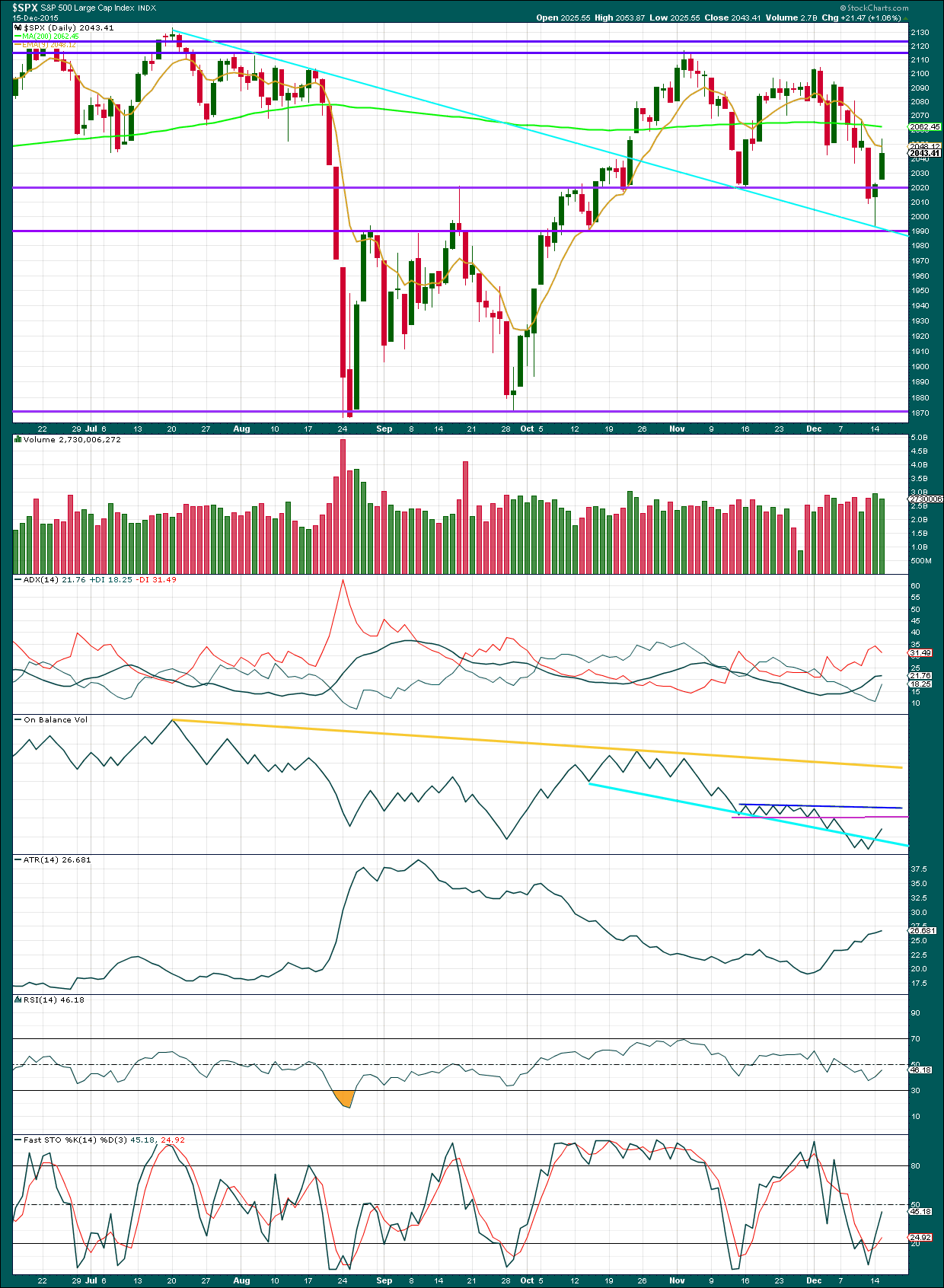
Click chart to enlarge. Chart courtesy of StockCharts.com.
Tuesday’s upwards day completes on slightly lower volume than Monday. The rise in price is not well supported by volume, so is suspicious. This offers some small support to the Elliott wave count at the hourly chart level.
It is very clearly a downwards day which has strongest volume during all movement since the August low. This offers some small support to the bearish Elliott wave count.
Price may be finding some resistance about the 9 day EMA. If price is trending, then a moving average should be useful to show where corrections end. Price remains below the 200 day moving average.
ADX is rising and above 20, a trend is indicated. The -DX line is above the +DX line so the trend is down. ATR agrees as it too is rising.
On Balance Volume broke above yesterday’s very short term gold line, so I have redrawn it. OBV has broken above the cyan line and may now find some resistance at the pink line.
RSI is neutral. If there is a downwards trend in place, then there is plenty of room for this market to fall.
Stochastics has returned from oversold.
DOW THEORY
For the bear wave count I am waiting for Dow Theory to confirm a market crash. I am choosing to use the S&P500, Dow Industrials, Dow Transportation, Nasdaq and I’ll add the Russell 2000 index. Major swing lows are noted below. So far the Industrials, Transportation and Russell 2000 have made new major swing lows. None of these indices have made new highs.
At this stage, if the S&P500 and Nasdaq also make new major swing lows, then Dow Theory would confirm a major new bear market. At that stage, my only wave count would be the bear wave count.
S&P500: 1,821.61
Nasdaq: 4,117.84
DJT: 7,700.49 – this price point was breached.
DJIA: 15,855.12 – this price point was breached.
Russell 2000: 1,343.51 – this price point was breached.
This analysis is published about 08:34 p.m. EST.

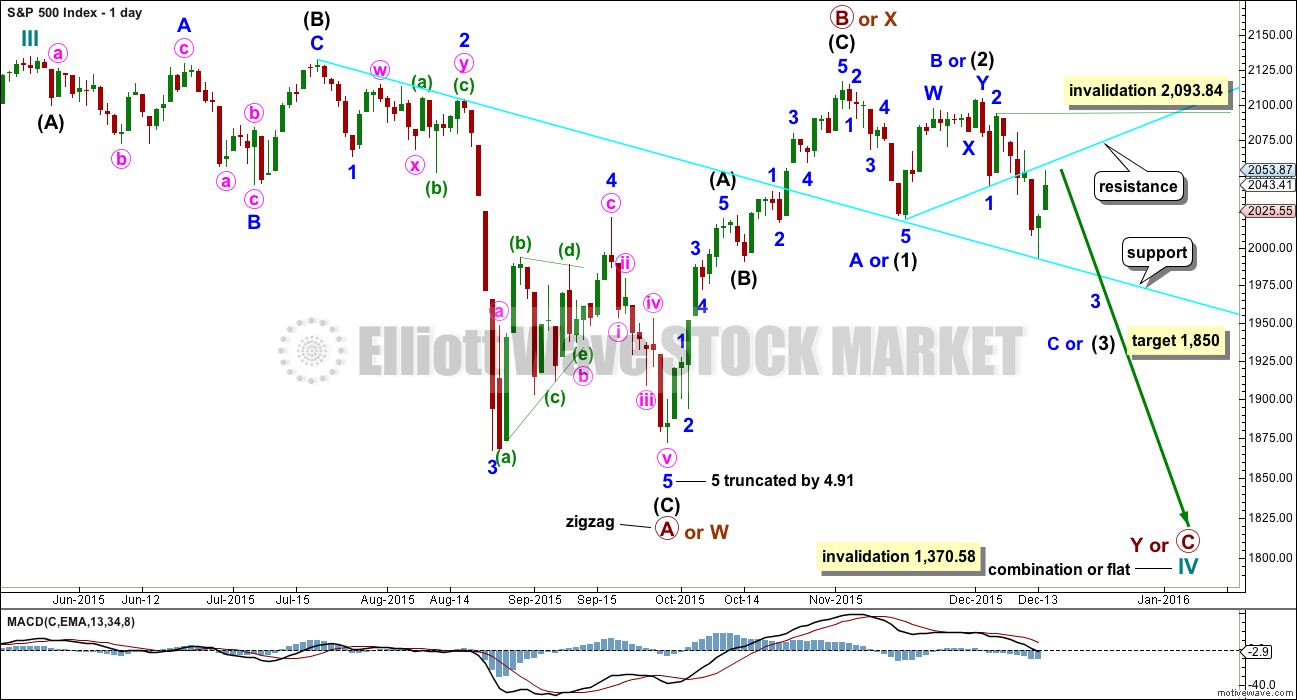
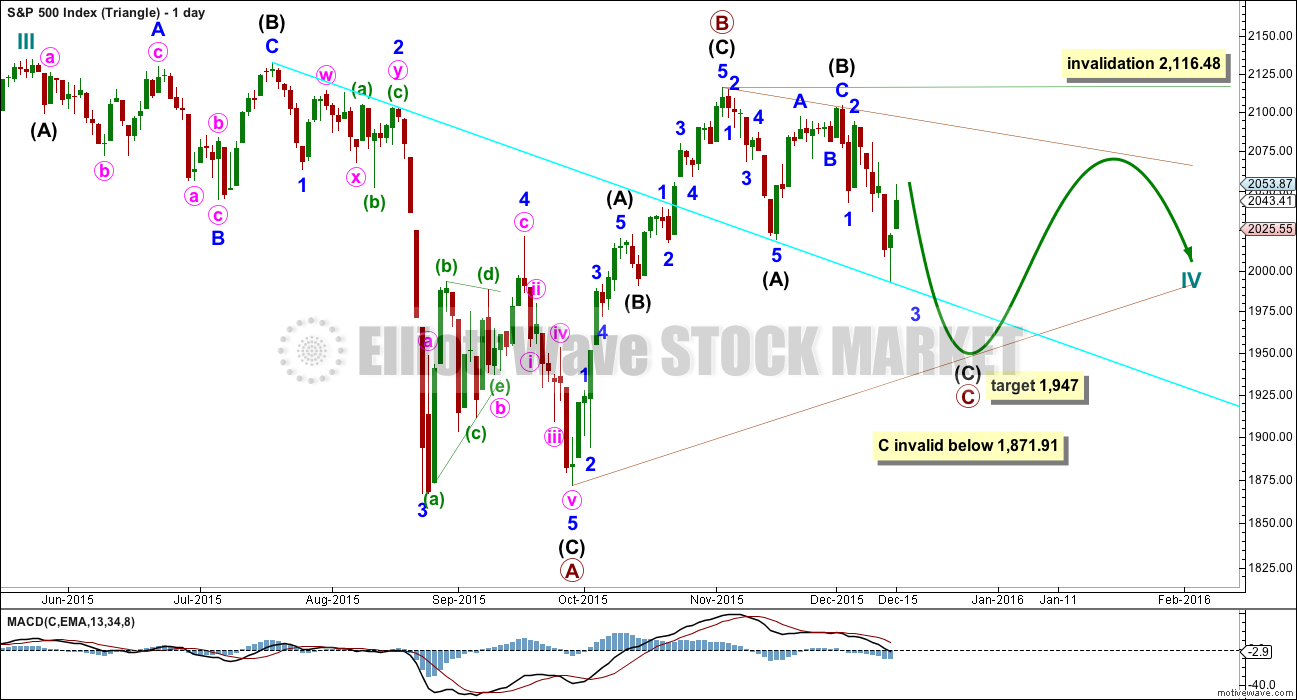
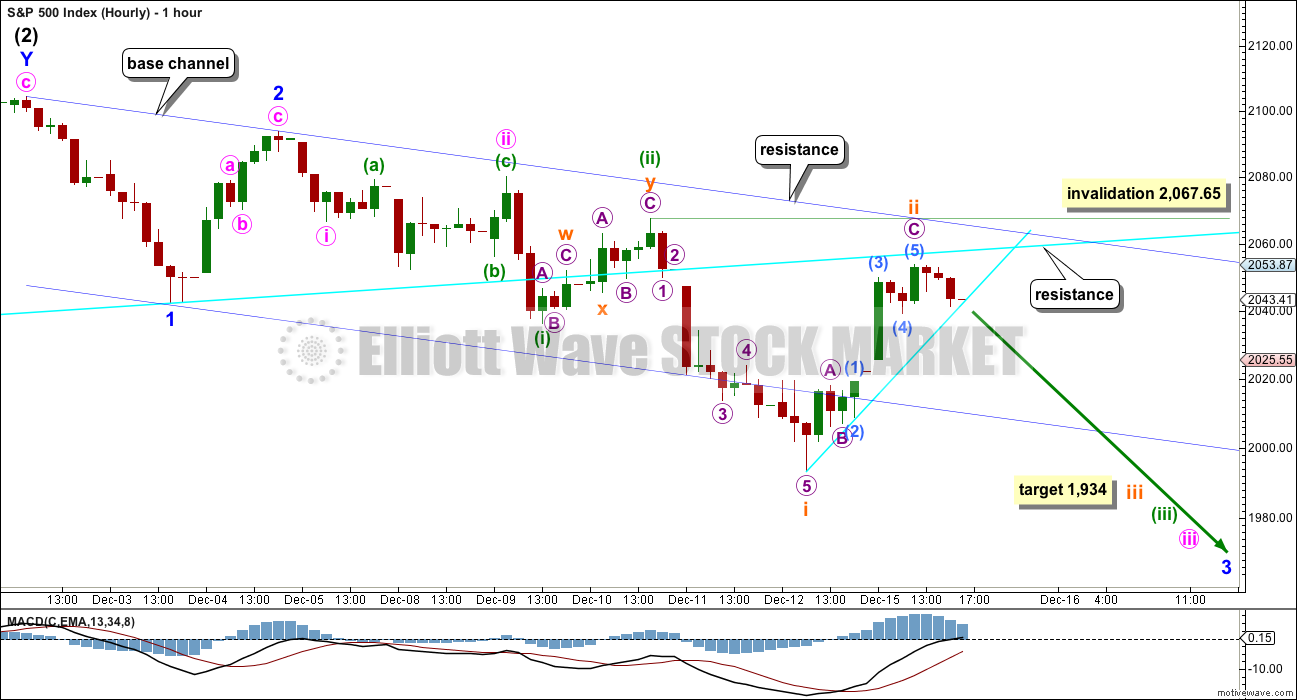


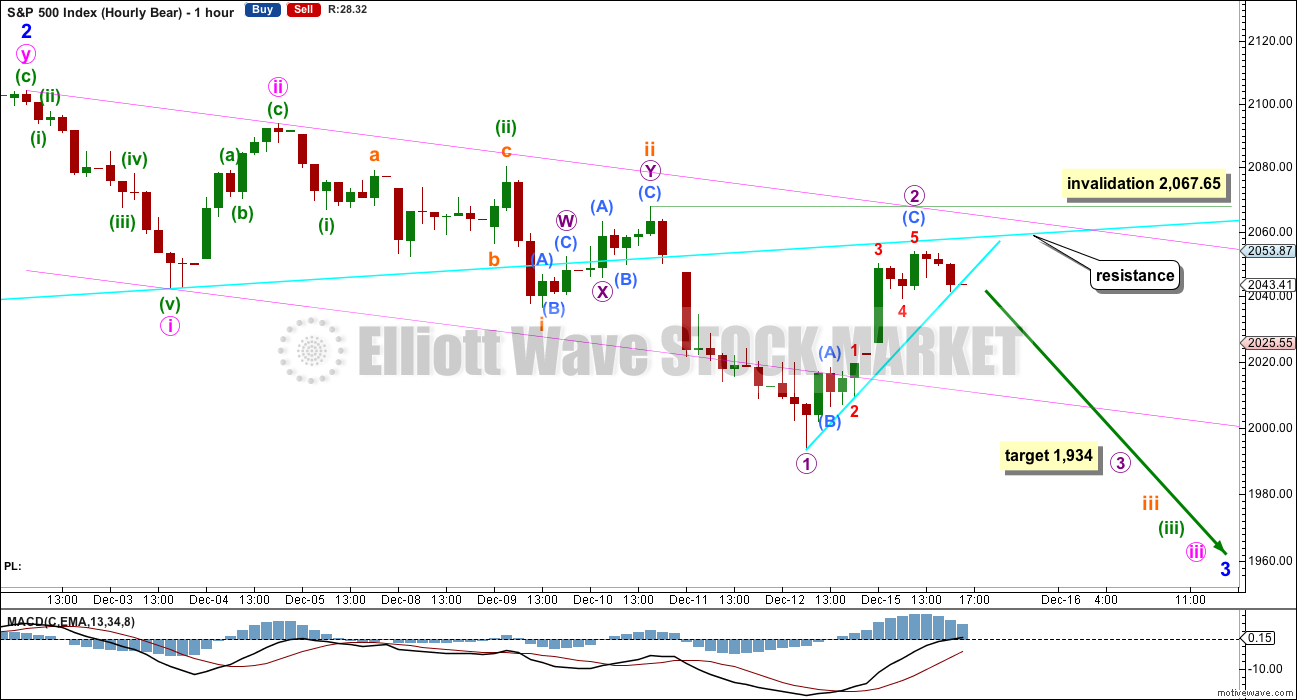
And the invalidation point was breached.
Towards the last low there are a bunch of overlapping corrections in there. The wave count will be changed to see that as a series of fourth waves.
This upwards move is still going to be seen as a second wave.
So far StockCharts data shows only slightly lower volume for today and that is a concern. A strong upwards day with slightly lower volume really does not support the wave count, but neither does it undermine it. The rise in price was not well supported by volume and so is somewhat suspicious.
I would have preferred to see a marked decline in volume.
OBV has come up to touch that pink trend line. Maybe this is the resistance for this upwards move?
I think we are headed to highs and we could test 2134.
As I said before this won’t be that easy to drop.
In summary we are looking at a tripple top ….
This is probably getting a bit out there, but since I mostly trade ES contracts, when I analyze the 2 hr chart I get 5 down since Dec 2, and now a 5 up.
I can’t ignore this stock / crude divergence.
Will try to post chart later.
i doubt it all time highs NEXT. Look at my notes the past few days i got really good analysis…
So you’re long the market?
Tommorow that is my plan
We could pull back 5-10 points and rip higher
options2014,
I will preface this post with the idea that I’m simply providing feedback to your request above to review your notes.
Bear with me as I’m a bit of a metrics/numbers freak.
Over the last three days, you’ve posted 103 times. You posted 4 charts and none included reference to counts. In those 103 posts, you were explicitly bullish in 16 of them, and explicitly bearish in 23 of them. Others were not as clear.
I think everyone appreciates thoughtful analysis, but constantly trying to keep score or bluster about hit rates probably doesn’t add much.
I like your energy, so keep posting analysis.
I’m a Fide rated chess champion and quant and honestly I am here to add value and learn as I was short term bearish but if you take the time to read all the posts by post carefully I gave updates as markets had the clues in either over night futures action. I’ve actually been on several trading groups and given credit calling the drop of aug 2015 to precision.
In any case I’ve lived and experienced the greatest markets in the world 2000 – 2007 upto now so it is what it is.
When we take out 2093 I wonder what you will say and park it at 2133+ Or higher in 10-20 trading days ?
While the greedy Bulls takes the Bears money!
I’m here to add productive values and I trade with passion and I am here to learn- I strongly recommend you go back to 2000 and 2007 and study how bull markets terminate. It could help you in your market endeavors.
My guess is, is one of these 1-2s that is going on now (to make for wave 2)…ATH with where we are in DJT, RUT2000, NYSE…is difficult to argue new all-time highs…I have to say though, I am ready to see the next move down
Not going to happen
Save my message
Just go back and look at my calls on markets
All upside stops for short positions taken out no doubt. As long as SPX does not take out 2093.84, I’m sticking with the second wave up scenario… 🙂
Not really
Just look at my precision calls on Vix and spx most of my trades played out
DOW up over one hundred points since picking up calls and hardly any movement…we may be looking at the final pop… 🙂
Did you get out of your VIX ETF or what ever it was ?
SPX hit the daily pivot at 2072
I re-invested half after the last pop and still hold some short term calls expiring this Friday and some later dated ones in two weeks. Also holding a few puts as downside hedges that have really popped the last two days…
i doubt it all time highs NEXT. Look at my notes the past few days i got really good analysis…
Well Well well. My initial target today was really the direction 2070. Uh oh!
Lara – side comment, but if we take out the lows in crude oil next few days, awesome analysis over on elliottwavegold.
Also, you’ve prepared a very good risk / reward set-up here on the S&P.
Let’s see if these third waves start playing out.
2062 now how much higher to consider the 3rd wave ?
I’m sure we can fit some type of count!
I’m quite surprised by the divergence in crude and stocks.
Thanks. I have a nice short position on Oil. I intend to hold it for quite a while, until this big third wave is done.
I think it was baked into the cake
Probably right John. I am really tempted to take the money and run on my upside hedges but I am curious to see how we trade into the close…I really don’t want get caught looking when Mr Third unleashes…I like the new single zig-zag for minute 2; right in line with action in UVXY…
Don’t let the lack of an immediate market reaction fool you. This rate hike has huge implications. We have had already the last week three failures of junk bond hedge funds and that is just the beginning. If anything convinces me of our being on the cusp of a massive third down today’s hike does the trick. Holding onto upside hedges for now but I think the die is cast…
On the hourly chart with this slight new high this upwards movement now has a better look as a single zigzag. Chart attached.
The lower cyan trend line (upwards sloping) is also redrawn. Price keeps breaking any of these short term trend lines.
Volume again will be important. I suspect it may be light, and if today completes a green candlestick on light volume that will be further support for the wave count.
If today completes a green candlestick on heavy volume that would be concerning. I would be looking for an alternate.
But as I type this it’s only just gone 2pm EST. The session isn’t over. If we have a red candlestick on heavy volume that would support the wave count.
Thanks for you update and analysis.
You’re welcome. Note also the short term target moves higher as the second wave moved higher.
I’ll add lower targets in today’s text analysis in case this one isn’t low enough.
I was thinking that C looked a bit brief and then the market popped higher; much better “right look” now for the zig-zag I think…
YES! Lara was so precise… AWESOME@
LOOK AT THAT CANDLE
RATES ARE IN 🙂
I don’t have any big downwards moves at all in my data?
oh sorry i was saying price action wise…. i think we head lower…. no jinx
Smart money saying no hike- dollar falling off a cliff…market headed higher…will it last?
They hiked!!!!!
Puerto Rico just announced they will default in January…If they do not hike, Gold will explode higher…
FED decision thirty minutes away. Picked up a few Friday expiration calls to hedge any surprises. I think we may get a pop either way which should be quickly reversed even if they decide to stand pat. A hike confirmation SHOULD see a strong move South.
Any ideas on wave structure?
Do we have five down on the 5 min chart?
IMHO, It is possible to come up with a 5 wave count. But there are many other possible counts as well. I am watching the downward sloping trend line and BB bands on the hourly chart. The trend line has to be taken out if the bull goes higher.
If it does not take out the upper trend line, it will move towards the lower trend line which is about 2000 right now.
I’m concerned that the move up to todays high looks like a 3 wave structure on the 2 min chart. Todays high either truncated or it was maybe a b wave (todays high possibly end of b of a triangle with c in progress right now?)
Look at the hourly chart. Don’t spend too much time worrying about much lower time frames.
The only thing I can think of to keep micro 2 in play is a rare triple zig-zag…
UVXY really needs to explode higher to confirm smart money loading up on insurance, a bit tepid so far…we have not even filled gap from yesterday…
Talk about sitting on a fence: XIV ……… (TVIX doing the same of course)
JUST IN – I agree 100% Today will be a BIG DOWN DAY!
the market is slowing fading into the meeting and OIL IS GETTING CRUSHED UH OH!
Fed situation is not a stock market bull deal
no change – financials get crushed
change – then, well no telling whats going to happen. If they do raise rates, I expect very interesting counter intuitive outcomes
3rd wave momentum looks like started to kick in
The smart money always knows what’s coming and tends to move ahead of the crowd. The key is figuring out what they are up to…
A hike in the FED rate, no matter how small, is a nail in the coffin of an already fragile bond market, which will inevitably issue is trouble for equities. This is a foregone conclusion and the market knows it. The only surprise (for most people) would clearly be a decision to NOT raise rates and if they do this and destroy any remaining credibility they have, the SHORT TERM result would be a rocket higher for the markets in anticipation of more party punch…not a bad idea to be holding a few OTM calls just in case though premiums are ludicrously elevated…there is a good reason…
Keep an eye on IYT. If it fills the gap from yesterday’s close at 135.93, it could be a good clue. A green UVXY print BEFORE the market turns negative would seal the deal from my perspective…
The thrust from the sideways movement and immediate reversal after the thrust I thinks supports Lara’s count. I am very suspicious of the “pump” higher AHEAD of any actual FED announcement. So far even the micro two count is holding so I am still bearish…won’t be surprised at one more spike to run remaining stops…
Verne,
Ok my closing comments before i actually shut down the computer.
Here is a hypo:
Market grinds here up + or – 7 handles. The FED comes out and raises rates with typical dovish comments added and it spikes higher to test globex highs and then reverse shoots lower 2019-2000 by close of today – NO JINX.
Reason: Where is the VIX going now. Not lower so this makes the most sense.
ALSO, the VIX is starting to form a HAMMER. You know what that means 😉
Take care!
Be careful out there. I know a trap when I see one…
Vern,
Bear trap or bull trap?
Thus far, these second wave corrections have been deep.
Hi Vernecarty,
Just to clarify – do you mean this is setting up to be a bear trap and you expect a spike higher?
Hard to call how the market will react at this point, whether the FED raises rates or not 🙂
TIA
StuartN
Key levels today: 2067.65 to keep micro 2 viable.
2093.84, start of minute 2 down.
We may see a slight overshoot of the cyan resistance line.
Once again, a much anticipated CB announcement may herald and interim high. Last time we saw this play out, the market front-ran Draghi and the ECB. It will be interesting to see how markets react to the FED.
indeed
Today the options market is pricing a 2.5% move up or down.
I’m shutting down… i give up already today. I’m not feeling good….
Premiums are through the roof, so the market is expecting a big move. I think the most important level that must hold for the bearish case is the top of minor two (for bull wave count) at 2093.84 so even a breach of the micro 2 point at 2067.65 would not cause me too much worry. Transports at a key inflection point and will probably give away the game; a break of 7,500.00
will be significant.
Hope you feel better options;
Not quite. Only slept a few hours last night watching Asian markets as well. Im burned out.
John
Looks like we will hit my initial bullish target and I even think 2100+ is here. Well, I hate to say I told you so. I think i have a 90% hit rate calling this market at this point..
I think we should wait for the CLOSE today my guess is 2070-2080 at this point. Nothing matters in a maniac bull market and I think I am not even going to bother with the screens today. I hope you guys keep on trying to find that drop one day.
Well,I hope you are making lots of money!
I do this for fun!
SPY pre market levels & indicators:
Son of a gun!
SPY got very close invalidation area 206.62 and still has a couple of hours to breach it
I do not know the implications of a pre market breach if it does not hold
SPY 5 MIN
hi lara,
i subscribed your gold service for several month,i never seen u never used trend(aqua) line like witch here used, this concept is very new to me,
Lara,
Thanks. I am looking for -100 point down day just like Aug 24 to be frank. Probably a 1%-2% down day tomorrow – NO JINX!